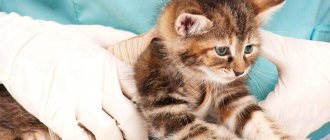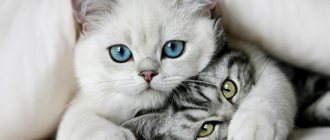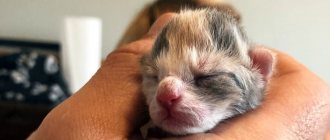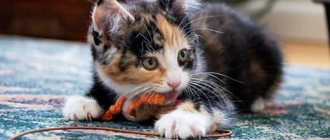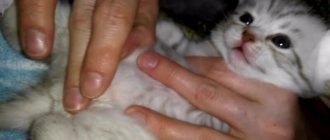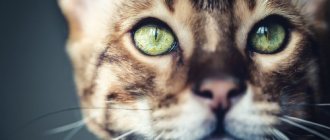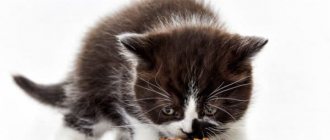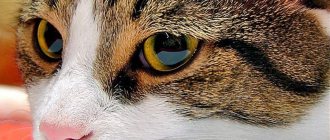The appearance and change of teeth in Maine Coons is a complex but natural process for all mammals. Kittens are born blind and toothless. The first “ladder” of teeth begins to emerge already in the 2nd week of life, and by 3 months of age the pet already has a full set of milk teeth: 12 on top and 14 on the bottom. From the 4th month, the process of replacing baby teeth with permanent ones begins.
When teeth change, symptoms
The cat's mouth contains 14 teeth on the lower jaw and 18 teeth on the upper jaw. By 8 months, baby teeth should fall out and molars will grow in their place.
Changing teeth in Maine Coons is a natural process. It begins at the age of 4-7 months. At birth, kittens have no teeth; after three weeks, the first front incisors grow.
Some people don’t even know when Maine Coons’ teeth change, since the pet’s behavior does not change. However, in most cases, kittens begin to play around and chew on all objects that do not lie well.
If your pet starts biting people, it means teething has started. This is not a pleasant process, as the gums become inflamed and become more sensitive.
In rare cases, permanent teeth grow next to baby teeth, which causes pain for the pet.
Features of dental development in cats and cats
By the age of eight months, the animal’s jaw is fully formed. An adult, no matter what gender, has 30 teeth.
At its core, a cat's teeth are a tool for cutting food. This is due to the fact that a cat is a predatory animal, and its main food is rodents and small animals. It is this fact that determines that cat teeth are very sharp; they can easily “cut” meat.
A cat's tooth consists of several parts:
- The pulp is a centered hollow cavity filled with capillaries containing nerve endings. This part is designed to nourish bone tissue.
- Dentine is a highly mineralized substance that fills the maximum space from the pulp to the outer shell. Dentin is essentially the base for the tooth. It is a hard material, but very sensitive. Prone to rapid destruction if the top protective layer is damaged.
- Enamel is a white shell that covers the outside of the tooth. It is not connected to nerves, so it has no sensitivity. Enamel is a complete protection against the negative effects of various factors. When this layer is abraded, eating causes pain.
Strong teeth are very important for a predator like a cat.
A cat's age can be easily determined by the condition of its teeth. Upon reaching 5–6 years of age, the animal has severely worn incisors, and the enamel turns yellow or even turns brown. Upon reaching 10–12 years of age, the animal is most often left without fangs.
At what age do baby teeth appear?
A newborn baby has no teeth. This fact is influenced by eating behavior. The kitten eats only mother's milk. If babies were born with teeth, this could injure the cat's nipples.
It is considered normal for a kitten to have all of its baby teeth before six weeks of age. They erupt in a certain sequence, if there are no pathological abnormalities.
Table: order of eruption of baby teeth in a kitten
| Age | Type of teeth | Number on the lower jaw | Number on the upper jaw |
| 2–3 weeks | incisors | 6 | 6 |
| 3–4 weeks | fangs | 2 | 2 |
| 3–6 weeks | premolars | 6 | 4 |
The total number of primary teeth is 26.
After the change, the cat's dentition is replenished with four molars
The difference from permanent teeth is not only in quantity, but also in color. The enamel is so white that it appears shiny. The first fangs are very thin and curved. On their inner side there is a second tooth, which disappears after replacing these teeth.
Milk fangs are incredibly sharp
It should be noted that kittens have teeth of amazing sharpness.
Loss of baby teeth and appearance of molars
The replacement of baby teeth with molars occurs gradually:
- The age of 3–4 months is the period when teeth begin to change. First, the incisors must be replaced. They will become the first permanent teeth.
- 4–5 months is the period of changing fangs. Immediately after them, the premolars are replaced.
- 4–6 months is the period of appearance of molars. It is noteworthy that they do not have dairy predecessors.
Knowing the timing of replacing baby teeth with molars, you can determine the age of the kitten.
The entire milk line changes by 6 months. It is rare, but there is a delay in shifts until the age of 9 months. This is not considered a deviation.
It is impossible to miss the moment of changing baby teeth to molars. It corresponds to certain symptoms:
- saliva is released profusely;
- gums become swollen;
- the pet tries to chew everything it comes across;
- rubs its muzzle with its paws;
- An unpleasant and pungent odor comes from the mouth.
The loss of a baby tooth can happen without the owner noticing anything. The kitten can even eat it with food.
I had several cats. All of them were taken from the street as kittens. I did not notice any pronounced symptoms in any of them indicating the change of baby teeth. True, from several pets, their baby fangs, found during cleaning, remained as a souvenir. I don’t know where the rest of the milk teeth went.
Peculiarities of teeth change in cats and male cats of different breeds
The development of kittens belonging to different breeds varies. This also applies to teeth.
British and Scots
Kittens of the British and Scottish breeds (both fold and straight) develop according to accepted standards. According to the breeders' rules, babies go for sale when they reach 3 months of age. The cat's teeth will begin to change after about 30 days of being in the new owner's house.
The peculiarity of these breeds is that the milk teeth have not fallen out, but the molars have already grown under them. The canines are at risk, followed by the incisors. As soon as a kitten notices signs of inflammation of the periodontal part on soft tissues or remains of primary teeth with grown permanent ones, you should immediately visit a veterinarian. If primary teeth begin to rot, the kitten’s oral cavity will be exposed to pathogenic microbes. Even as an adult, a cat may subsequently suffer from diseases of the teeth and gums.
A missing baby tooth can cause chronic gum disease in a cat as an adult.
Kittens of Siamese and Thai breeds
Among Siamese and Thais, special attention is paid to the canines, since in these breeds their structure differs in length and thickness. Consequently, fangs grow more slowly. Here it is important to make sure that during the process of growing the permanent ones, the milk ones fall out. Siamese kittens do not suffer from delayed teething. The upper and lower canines should be replaced before 6 weeks of age. There is no need to worry if the baby fang has fallen out and the permanent one is not yet growing. It will cut through without problems in standard time.
Bengal cats
Heredity directly affects the formation of a Bengal kitten. Typically, a baby's teeth begin to change at the age of 5 months. Accelerated shedding can occur, but this is rare and is genetic. That is, baby teeth will fall out a little earlier than permanent teeth erupt. But before the age of 6 months, the molars must emerge. Then you don't have to worry. If this does not happen, then there may be a lack of microelements in the kitten’s body. In this case, problems with the coat will simultaneously arise. The pet owner should consult a veterinarian.
Sphinxes
Sphynx cats change their teeth between 3 and 6 months of age. The characteristics of the breed dictate their conditions, affecting the delay in the loss and growth of fangs. The molars will not erupt until the baby teeth fall out. Veterinarians note that due to the characteristics of the breed, the baby canine can grow only after one year.
Sphynx cats often suffer from jaw problems even as adults. There are frequent cases of owners complaining about the small size of their fangs.
The owner of the Sphynx should closely monitor the process of changing teeth in his pet
Change of teeth in a Maine Coon kitten
The Maine Coon is a large cat. Dental problems are quite common in this breed. The period of their change can extend up to the age of 8 months. Generally accepted norms say that a Maine Coon is considered a kitten up to 15 months. Consequently, molars can take up to a year to grow. The main thing is to pay attention to the fact that the teeth have parallel rows. The correct bite for a Maine Coon is a scissor bite. It is highly recommended that you buy your kitten plenty of toys to help him scratch his gums. Maine Coons have the temperament of dogs and often, when playing around, chew wires, shoes and can damage furniture.
Siberian cats
Although the kittens of Siberian cats are large in size, their teeth change as standard. If there is a delay, it means that feeding requires more balance. Sometimes males or the largest kittens can delay the change of teeth by 4 weeks from normal.
Table: what teeth does the permanent row consist of?
| Upper jaw | Tooth name | Quantity |
| Fang | 2 | |
| Cutter | 6 | |
| Premolars | 6 | |
| Molars | 2 | |
| Lower jaw | Fang | 2 |
| Cutter | 6 | |
| Premolars | 4 | |
| Molars | 2 |
An adult cat normally has 30 teeth.
Video: cat's baby teeth
What to do
If you notice changes in behavior, check to see if your Maine Coon's teeth are changing. This is evidenced by inflammation and redness on the gums.
In this case, the pet needs to be wiped with a decoction of chamomile, oak bark, and sea buckthorn oil. You can find special ointments at your veterinary pharmacy.
If a kitten scratches its teeth on its owner, this should not be encouraged. This habit may persist over time, making it more difficult to wean a Maine Coon.
The pet store sells special toys for kittens whose teeth are changing. They are soaked in a solution of catnip, which will undoubtedly attract the baby.
Examination of the jaw is important when changing teeth. If you notice the proximity of milk and molar teeth, you need to visit a veterinarian. It is strictly forbidden to remove temporary teeth on your own; this can cause irreparable harm to your pet.
Changing teeth in Maine Coons is a natural process/Yandex Collections
This anomaly causes the development of malocclusion. Pathology is a reason for disqualification at exhibitions and reduces the quality and life expectancy of a cat.
Don't forget to brush your teeth regularly. Maine Coons are prone to developing caries and tartar formation. Removal of the latter is permissible only in a veterinary clinic.
You can prevent caries by daily rubbing your teeth with rosehip decoction. In addition, nutrition directly affects the condition of the oral cavity, so choose high-quality and balanced food.
Price
The price of a kitten of this breed depends on its status. There are three groups of animals that differ in cost:
- Show class.
- Brit class.
- Pet class.
The first category is animals intended for participation in exhibitions.
They cost more than all the others. The price can reach 100 thousand rubles.
The future owner of a Maine Coon pays this amount for a quality animal that meets the breed standards.
It has a purebred pedigree and will be able to exhibit and receive awards. It is used for mating.
The second group are female kittens suitable for breeding. They can produce show class offspring. They cost 30-35 thousand rubles. These cats have slight deviations from the standards, for example, too long or short hair, incorrect color or eye color. This does not affect their ability to exhibit and receive awards at shows.
The third group is exclusively pets for the home. They are the cheapest - 15-20 thousand rubles. They have many deviations from the breed standard and therefore cannot participate in exhibitions. They will not be used for mating either. But they possess all the other advantages of the breed - appearance, character - and therefore will become wonderful pets.
What else affects the price?
- The most expensive will be a kitten under 4 months of age.
- Cats are more expensive than cats.
- Unusual colors are more expensive.
- Mental abilities of the breed.
The intelligence of Maine Coons is absolutely consistent with their appearance and size.
These cats are considered real philosophers.
They think well, learn easily, and are capable of contemplation.
Their actions are logical, they are able to perform conscious actions (the same qualities are attributed to some types of dogs, for example, border collies and Labradors). Maine Coons have a very good memory, they can remember many words and commands.
They are well versed in intonation, distinguish human speech, its nuances, gestures and even understand glances. Maine Coons are called thinkers because they are able to remain in a state of peace and observation for a long time. Cats are not isolated from kittens even in the first minutes of their birth. Male Maine Coons actively participate in the life of their offspring, in raising and playing with kittens.
Immunity. Is it possible to get vaccinated?
During the period of teeth change, the immunity of Maine Coons is weakened. Vaccination is carried out at 3-4 months. This is important because when replacing baby teeth with molars, Coons have a greater chance of contracting the disease. If this could not be done, vaccinations are done closer to a year.
Pets undergoing teeth replacement can easily catch a virus and infection, so you shouldn’t walk them outside.
It is recommended to wash shoes with disinfectants after returning home, especially if the kitten has access to them.
Shedding
Seasonal renewal of fur occurs in spring or early summer. The Maine Coon sheds quite quickly and, with regular brushing, does not cause trouble to its owners.
Older Maine Coons undergo age-related shedding, which lasts from 12 to 18 months. During this period, the animal sheds a lot and loses most of its fur, so it is very important to give your pet vitamins and make sure that the food corresponds to the age norm of the pet.
The following factors can also lead to sudden hair loss:
- skin parasites;
- worms;
- metabolic disease;
- diseases of internal organs;
- unbalanced diet;
- pregnancy;
- elderly age;
- stress.
A veterinarian can help you find out why your cat sheds. He will conduct an examination, make a diagnosis and prescribe treatment.
Complications when changing teeth
Most often, Maine Coon teeth change without complications. When owners observe reddened and inflamed gums, they are horrified and run to the veterinarian for a consultation.
However, this is a normal phenomenon and does not require additional procedures.
Symptoms to watch out for:
- lack of appetite;
- excessive gum inflammation;
- lack of activity;
- formation of suppuration on wounds;
- state of anxiety;
- The baby teeth have not fallen out, although the permanent ones have already grown.
If you observe at least one of the symptoms, you should immediately contact a veterinarian for help.
Do not self-medicate, as the cat could have an infection that could threaten its life.
One of the serious complications is gingivitis. Main symptoms:
- inflamed gums and palate;
- poor appetite;
- bleeding;
- unpleasant odor from the mouth;
- tousled fur on the chest.
If one of the symptoms is detected, take the cat to a veterinary clinic. Otherwise, the risk of developing periodontal disease increases, as a result of which the cat will lose all its teeth.
Change of teeth in Maine Coons most often occurs without complications/Yandex Collections
Oral hygiene
For an adult Maine Coon, timely teeth cleaning is important. The health of the cat largely depends on them. You need to accustom your baby to oral care from the first days of his stay in your home, and then your adult cat will be more tolerant of hygiene procedures. So that your coon can receive worthy awards at shows and please you for a long time, learn to brush your pussy’s teeth:
- Wash your hands first.
- Take the cat on your lap, calm it down, and prepare for the procedure.
- Gently open your pet's teeth and begin rubbing them in a circular motion. In the first stages, accustom your baby to brushing using available means: your own finger wrapped in gauze, a human toothbrush. In the future, you can purchase a special cat brush and paste.
- When you finish brushing your teeth, praise your baby. You can give him some of his favorite treat.
What to feed
Some caring owners, when Maine Coon kittens' teeth change, feed them exclusively soft food. This method of feeding is erroneous.
When changing baby teeth to permanent ones, the diet cannot be changed. It is supplemented only with fortified supplements purchased at a veterinary pharmacy.
In particular, it is necessary to ensure sufficient amounts of calcium and phosphorus in food.
- When changing teeth, kittens should be fed the following foods:
- dry fortified food;
- porridge;
- red meat;
- vegetables;
- cartilage;
- dairy products.
Veterinarians recommend not giving up dry food, as it contains minerals that prevent the development of caries and tartar.
Choose ready-made food according to the age of your pet. This food will be the most balanced.
At what age does replacement occur?
Already from the age of three months, the baby's milky bone processes in the mouth begin to fall out.
When the kitten is 3-4 months old, the baby teeth fall out and change. Permanent teeth are cut gradually - first, new incisors appear, then fangs, small and large on the sides. Maximum up to 8 months. In life, they are all located in their places, and consist of 14 lower and 16 upper. If the process itself is asymptomatic, then it can be noticed by the pet’s behavior. At this time, cats begin to chew everything, they often salivate heavily, and a smell appears from the mouth, which is absolutely natural.
How to brush your teeth
Maine Coon teeth brushing is practically no different from human brushing / Yandex Collections
Buy a special toothpaste at a veterinary pharmacy, then follow the instructions:
- Take the cat;
- Lay it on its side;
- Gently expose your teeth;
- Apply paste to brush;
- Brush your teeth without pressing.
For every animal this procedure is stressful. To calm him down a little, treat your Maine Coon to his favorite treat.
Maine Coon: nutrition and care
If a Maine Coon kitten has appeared in your home, then you have already appreciated its intelligence and intelligence. This pet never ceases to amaze and delight its owners with pranks, tenderness, and funny incidents.
However, caring for and maintaining a Maine Coon kitten requires special attention. That is why in our article we have collected as much useful information as possible about the features of keeping cats of this breed.
What to feed a Maine Coon?
There is no consensus on the correct diet for a Maine Coon. Some believe that the right decision would be to choose professional food, while others argue that you need to make a choice in favor of natural food. Still others (and the majority) talk about the benefits of mixed feeding.
When choosing ready-made food, pay attention to their quality. It is best to use premium food specially developed for the Maine Coon breed.
They will provide your pet with all the necessary nutrients, including minerals and vitamins.
If your pet eats only ready-made food, then there is no need to offer him additional vitamin complexes.
What can a Maine Coon eat from natural products? Lean boiled meat (turkey, chicken, beef) is excellent for Maine Coon nutrition. From fish, you can offer your pet trout, herring, salmon and other boiled fish of noble varieties. When preparing food for your pet, avoid adding salt and spices.
If the pet is on mixed feeding, then high-quality industrial food is taken as the basis, and natural products are used as a supplement. But no matter what type of food you choose, make sure to add sprouted oats to your Maine Coon’s diet, which your pet needs to periodically cleanse the stomach.
Maine Coon coat care
The best evidence that your pet is healthy and you are caring for it properly is the condition of its coat.
When properly cared for, the Maine Coon's coat gives the pet a unique, charming appearance of a wild but gentle animal. Maine Coons' fur grows continuously. Therefore, the problem of pet shedding is especially acute.
Throughout the year, the Maine Coon's coat is constantly renewed. Some hairs fall out, some grow back. Hair growth is very active - about 0.5 cm per week.
Maine Coons and other long-haired cats should be combed in the direction from head to tail, and the lush mane, on the contrary, should be combed in the opposite direction.
From the very beginning, try to make grooming your pet a pleasant and painless procedure.
Maine Coon: nail care
Like any Maine Coon cat, its claws need to be sharpened. If you want to protect furniture and wallpaper from the sharp and strong claws of your pet, make sure that there is a special scratching post in the house.
You can find the necessary device at any pet supply store. Our online store is no exception. Our range includes horizontal and vertical scratching posts, as well as special houses for your pet.
However, even with a scratching post, the Maine Coon's claws wear down quite slowly. In urban environments, you will have to take care of trimming your nails. You can do this on purpose using special nail clippers, or contact a specialist.
Maine Coon Ear and Eye Care
Carefully monitor the condition of your pet's ears. If your Maine Coon is healthy, his ears should be pink in color, with no serious buildup of earwax. If the ears become dirty, use cotton swabs to clean them.
Maine Coons should not have mucus accumulate in the corners of their eyes. If you observe mucus discharge, it must be removed immediately. Such a symptom may indicate the presence of an infectious disease.
Wipe your cat's eyes with a cotton swab soaked in a weak solution of boric acid and contact your veterinarian.
Maine Coon Teeth and Gums Care
Often, owners do not pay enough attention to caring for their Maine Coon's teeth, considering it unnecessary. The teeth of cats of this breed are very large and sharp. But you shouldn’t neglect caring for your pet’s teeth.
Make sure your cat gets food that is hard enough to clean its teeth.
And also make it a rule to periodically brush your pet’s teeth with a special toothpaste. Teach your kitten to such hygiene from childhood.
